So I bailed on reefing for 10 years....I had a successful tank back in the day with no 2 part no calcium reactor no controllers no dosing pumps no ato no auto water etc etc.....Instant ocean....skimmer....fuge....trace... Kalk...and t5s that "wouldn't grow sps" so I never tried! Just bought a used system with all of the latest greatest stuff......AND...... I want to try and keep my old methods and incorporate the new mostly for ease and convenience....anyone else feel the growing pains? Open for advice cause I definitely will never know it all!
Navigation
Install the app
How to install the app on iOS
Follow along with the video below to see how to install our site as a web app on your home screen.
Note: This feature may not be available in some browsers.
More options
You are using an out of date browser. It may not display this or other websites correctly.
You should upgrade or use an alternative browser.
You should upgrade or use an alternative browser.
New school vs old school!?
- Thread starter Bccarty151
- Start date
- Tagged users None
- Joined
- Aug 12, 2018
- Messages
- 5,806
- Reaction score
- 8,226
I predict you will do fabulously with that strategy. Best wishes! 
Hopefully you didn't buy-back-in after getting out of the hobby
If you did...sell everything and

- Joined
- Aug 12, 2018
- Messages
- 5,806
- Reaction score
- 8,226
Have you considered a FOWLR tank, or are you set on having corals?
Already mortgaged my house n bought corals!Have you considered a FOWLR tank, or are you set on having corals?
Just looked at the price of a yellow tang not sure fish would be cheaper!Already mortgaged my house n bought corals!
What corals did you buy? Do you have a tank thread that describes your “new school” system?
There is nothing that worked back then that does not today. Biology is the same. Chemistry is the same. My lights are older than 10 year and so is a lot of my equipment.
The only real changes that I can tell is the abundance of better food (both pellets and mysis) and Hannah Ultra Low Phosphorous Checker. Otherwise, just different versions of the same things... and many are not better just because they are newer.
The only real changes that I can tell is the abundance of better food (both pellets and mysis) and Hannah Ultra Low Phosphorous Checker. Otherwise, just different versions of the same things... and many are not better just because they are newer.
I bought a used system that's 2 years old so I technically didn't build it but I am currently rebuilding it kinda. It's a red sea 425xl with Hydra 26's. Had a gfo reactor and co2 reactor both removed. It has a reef octopus skimmer with a varios 2 pump that I'm running half time may limit use to an as needed basis. Ghl auto water change system currently not using as I do not plan on regular water changes. Uv light that I am using until I start dosing phytoplankton. Tank was started with dry rock I have live rock on order. It came with the new Neptune apex setup that I like and will be keeping. Tank is beautiful and grows corals well but it's sterile and fragile like a house of cards ! Look at it wrong and it'll get hurt feelings and boom a problem arises....just trying to get back to the stability and diversity of my old school Tank but hang onto the new stuff that makes it easierWhat corals did you buy? Do you have a tank thread that describes your “new school” system?
+10 to what jda said.I bought a used system that's 2 years old so I technically didn't build it but I am currently rebuilding it kinda. It's a red sea 425xl with Hydra 26's. Had a gfo reactor and co2 reactor both removed. It has a reef octopus skimmer with a varios 2 pump that I'm running half time may limit use to an as needed basis. Ghl auto water change system currently not using as I do not plan on regular water changes. Uv light that I am using until I start dosing phytoplankton. Tank was started with dry rock I have live rock on order. It came with the new Neptune apex setup that I like and will be keeping. Tank is beautiful and grows corals well but it's sterile and fragile like a house of cards ! Look at it wrong and it'll get hurt feelings and boom a problem arises....just trying to get back to the stability and diversity of my old school Tank but hang onto the new stuff that makes it easier
I have been skimmerless for > 40 years. For my purposes they remove components of the microbial loop which moves live food (carbon) up the food chain.
In my experience. Oxygen is a Most important parameter, especially when lights out. All systems I build use robust circulation (vertical loop current) at the surface to maximize gas exchange.
I have my power heads in tank agitating the surface pretty good as it's using around 2 gallons a day from the auto top off lol. I also forgot to mention I did add chaeto to the sump and removed the filter socks so hopefully I will get oxygen exchange there.+10 to what jda said.
I have been skimmerless for > 40 years. For my purposes they remove components of the microbial loop which moves live food (carbon) up the food chain.
In my experience. Oxygen is a Most important parameter, especially when lights out. All systems I build use robust circulation (vertical loop current) at the surface to maximize gas exchange.
My concern about dropping the skimmer entirely right now is that my coral load on the tank is relatively light so I'm not getting much filtering from them yet. But I agree with your view on skimmers and that's why I'd like to remove it.
If you don't plan on changing water, then read up on how a skimmer can help the buildup of toxic metals by removing them through bound organics. They have to get out some way with water changes and skimmers being the most common methods. They can bind to aragonite for a while, but this is not removal.
Before anybody posts it, ICP is not the answer here. There are too many forms of metals and compounds that they cannot test for... this is why people with problems get all excited that an ICP test will tell them what to do and all that they get is inconclusive results or a big ole nothing-burger. ...which is why I did not list ICP tests in the list of things in the last 10 years that is needed.
Before anybody posts it, ICP is not the answer here. There are too many forms of metals and compounds that they cannot test for... this is why people with problems get all excited that an ICP test will tell them what to do and all that they get is inconclusive results or a big ole nothing-burger. ...which is why I did not list ICP tests in the list of things in the last 10 years that is needed.
Where is your live rock coming from? While some micro fauna & fana on live rock will colonize in your substrate. I suggest you get some mature live sand, again I like diver collected. If your system has a refugium or sump, allow detritus to accumulate and energize the “microbial loop” with MULM.
PS. In addition to opposite phyto cycle for oxygen enricement, I prefer cascading water from display tank to refugium. This provides stellar gas exchange 24/7. Some consider this noise, I consider it essential gas exchange.
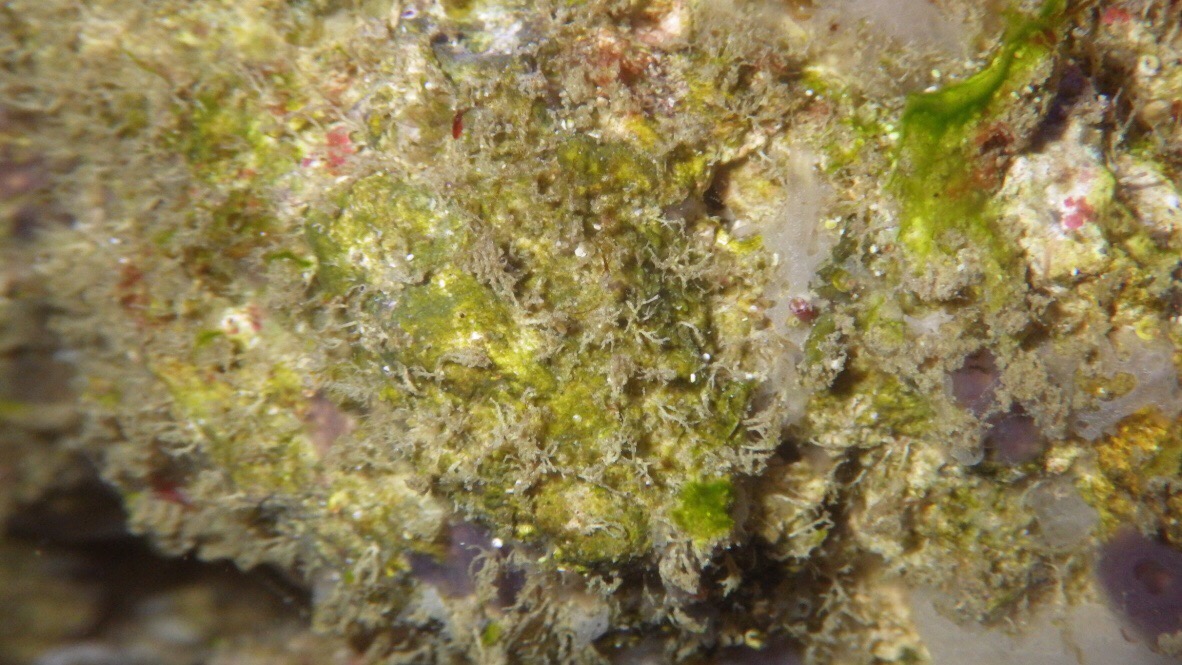
 wamas.org
wamas.org
I think one of the most important, and least understood or mentioned things in a reef tank is "mulm". That stuff that grows in the dark portions of a tank if it is set up long enough. "Mulm" is a combination of algae, sponges, bacteria, pods, worms, detritus, poop and any thing else that can be propagated or grown in the dark. I realize most people would immediately get out the sponge, razor blade or grenade to remove it but there is a word I like to use to describe those people. That word is "wrong". Mulm is a natural product that you will find in the sea all over the world. Our tanks run on bacteria, algae and a food chain. Bacteria and a food chain are dependent on having a place to reproduce. Mulm is the perfect place. Rocks and glass are flat surfaces that are only two dimensional. Mulm makes these places three dimensional allowing much more space for bacteria and microscopic organisms to grow and do the macarana. (Then love to dance) Pods, which are needed for any small fish also need to eat and their numbers are directly related to how much food they can get their hands on (or whatever pods use to eat with) The more food, the more pods, the more pods, the easier to keep smaller fish. Larger fish such as copperbands and angels also eat pods.
Many people try to keep fish such as pipefish, mandarins or other dragonettes in a sterile tank and while feeding them a couple of times a day with tiger pods or some other expensive food. Those types of fish will not live for long in such a tank and they certainly won't spawn which I consider the "only" criteria to determine the state of health for any paired fish.
Mulm (after a while, maybe a few years) should grow on the back and sides of glass as well as under rocks.
Here in this picture of my clingfish, the mulm appears green. It is really brownish and that fish is on the side of my tank. I brightened up the picture and turned it sideways because it was in the dark and the fish was hard to see.
There is a thick layer of it on the back of my tank where my mandarins and pipefish like to hunt. My long spined urchin also grazes there most of the time as there is not much algae in my tank for him to eat. He is many years old as are the mandarins and pipefish and they are dependent on this food source.
A sterile tank IMO is the biggest problem we have keeping certain fish healthy.
Sterile is good in an operating room but very bad in a tank.
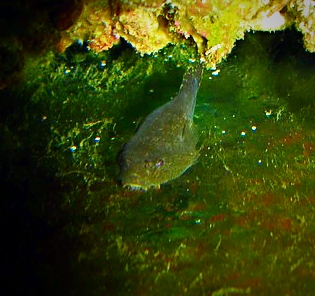
I recently took this off Kauai Hawaii. The rocks are covered in Mulm. You can see a spotted moray eel in the center.
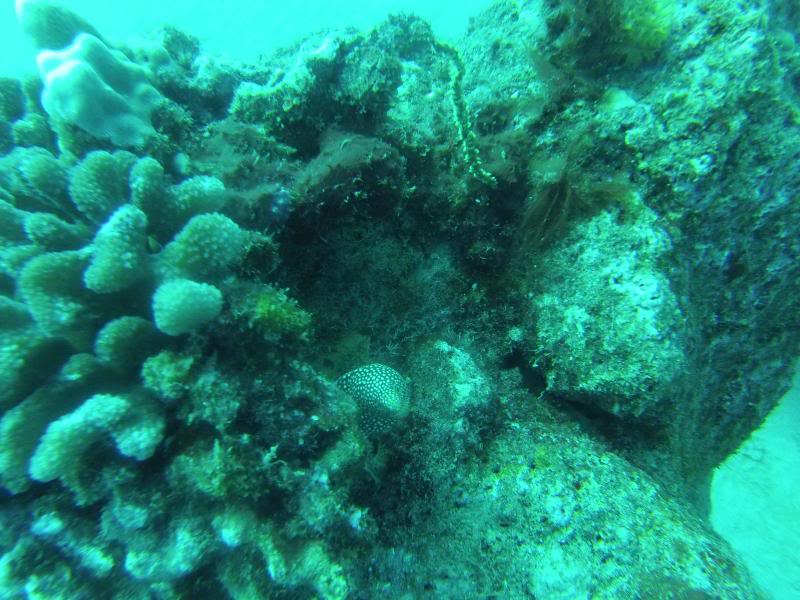
This was in the Caribbean. The mulm provides food for those fry.
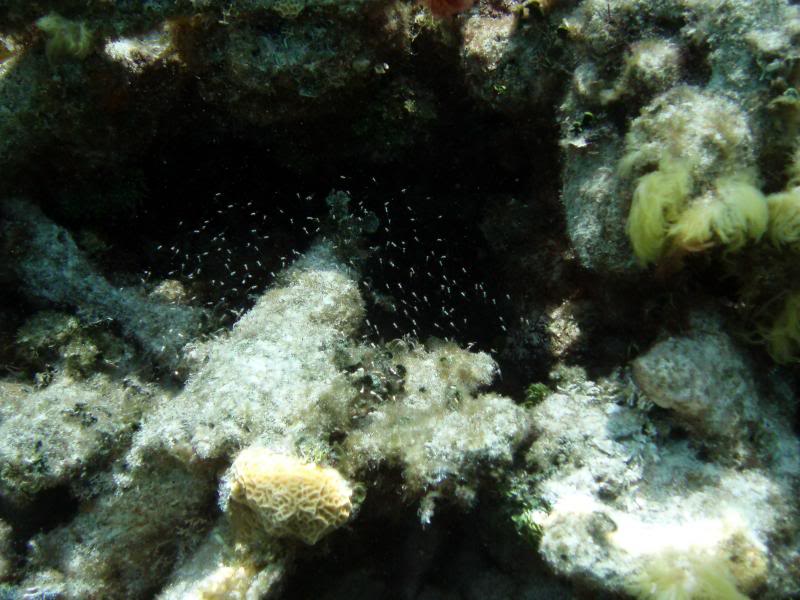
This is off a mangrove Island in Key Largo Florida. Notice the growth on the roots.
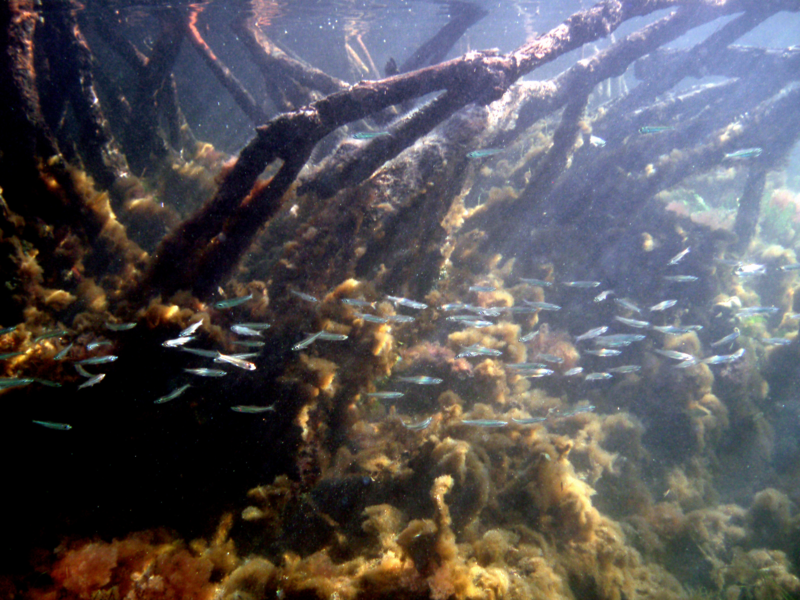
I know many people will disagree with me. That is fine. But everything I propose I post pictures to back up my theories. None of my ideas come from re-hashed, inside the box rumors.
PS. In addition to opposite phyto cycle for oxygen enricement, I prefer cascading water from display tank to refugium. This provides stellar gas exchange 24/7. Some consider this noise, I consider it essential gas exchange.

"Mulm" in a reef tank
I think one of the most important, and least understood or mentioned things in a reef tank is "mulm". That stuff that grows in the dark portions of a tank if it is set up long enough. "Mulm" is a combination of algae, sponges, bacteria, pods, worms, detritus, poop and any thing else that can be p...
 wamas.org
wamas.org
I think one of the most important, and least understood or mentioned things in a reef tank is "mulm". That stuff that grows in the dark portions of a tank if it is set up long enough. "Mulm" is a combination of algae, sponges, bacteria, pods, worms, detritus, poop and any thing else that can be propagated or grown in the dark. I realize most people would immediately get out the sponge, razor blade or grenade to remove it but there is a word I like to use to describe those people. That word is "wrong". Mulm is a natural product that you will find in the sea all over the world. Our tanks run on bacteria, algae and a food chain. Bacteria and a food chain are dependent on having a place to reproduce. Mulm is the perfect place. Rocks and glass are flat surfaces that are only two dimensional. Mulm makes these places three dimensional allowing much more space for bacteria and microscopic organisms to grow and do the macarana. (Then love to dance) Pods, which are needed for any small fish also need to eat and their numbers are directly related to how much food they can get their hands on (or whatever pods use to eat with) The more food, the more pods, the more pods, the easier to keep smaller fish. Larger fish such as copperbands and angels also eat pods.
Many people try to keep fish such as pipefish, mandarins or other dragonettes in a sterile tank and while feeding them a couple of times a day with tiger pods or some other expensive food. Those types of fish will not live for long in such a tank and they certainly won't spawn which I consider the "only" criteria to determine the state of health for any paired fish.
Mulm (after a while, maybe a few years) should grow on the back and sides of glass as well as under rocks.
Here in this picture of my clingfish, the mulm appears green. It is really brownish and that fish is on the side of my tank. I brightened up the picture and turned it sideways because it was in the dark and the fish was hard to see.
There is a thick layer of it on the back of my tank where my mandarins and pipefish like to hunt. My long spined urchin also grazes there most of the time as there is not much algae in my tank for him to eat. He is many years old as are the mandarins and pipefish and they are dependent on this food source.
A sterile tank IMO is the biggest problem we have keeping certain fish healthy.
Sterile is good in an operating room but very bad in a tank.

I recently took this off Kauai Hawaii. The rocks are covered in Mulm. You can see a spotted moray eel in the center.

This was in the Caribbean. The mulm provides food for those fry.

This is off a mangrove Island in Key Largo Florida. Notice the growth on the roots.

I know many people will disagree with me. That is fine. But everything I propose I post pictures to back up my theories. None of my ideas come from re-hashed, inside the box rumors.
I had my well (880ft deep) tested prior to buying my place and there test found no toxic substances. Yes I'm using well water (yikes). I have ran basic tests on it and it came back pretty close to target numbers on alk phos and Nitrate. I did have a pretty cruddy (turbofloter?) Skimmer on my last reef tank but it didn't work all that well if at all.If you don't plan on changing water, then read up on how a skimmer can help the buildup of toxic metals by removing them through bound organics. They have to get out some way with water changes and skimmers being the most common methods. They can bind to aragonite for a while, but this is not removal.
Before anybody posts it, ICP is not the answer here. There are too many forms of metals and compounds that they cannot test for... this is why people with problems get all excited that an ICP test will tell them what to do and all that they get is inconclusive results or a big ole nothing-burger. ...which is why I did not list ICP tests in the list of things in the last 10 years that is needed.
Your insight and experience is invaluable thanks again! I am lighting fuge opposite of the display. When I removed the filter socks I got noisy waterfalls. Are you using phytoplankton in your program?Where is your live rock coming from? While some micro fauna & fana on live rock will colonize in your substrate. I suggest you get some mature live sand, again I like diver collected. If your system has a refugium or sump, allow detritus to accumulate and energize the “microbial loop” with MULM.
PS. In addition to opposite phyto cycle for oxygen enricement, I prefer cascading water from display tank to refugium. This provides stellar gas exchange 24/7. Some consider this noise, I consider it essential gas exchange.

"Mulm" in a reef tank
I think one of the most important, and least understood or mentioned things in a reef tank is "mulm". That stuff that grows in the dark portions of a tank if it is set up long enough. "Mulm" is a combination of algae, sponges, bacteria, pods, worms, detritus, poop and any thing else that can be p...wamas.org
I think one of the most important, and least understood or mentioned things in a reef tank is "mulm". That stuff that grows in the dark portions of a tank if it is set up long enough. "Mulm" is a combination of algae, sponges, bacteria, pods, worms, detritus, poop and any thing else that can be propagated or grown in the dark. I realize most people would immediately get out the sponge, razor blade or grenade to remove it but there is a word I like to use to describe those people. That word is "wrong". Mulm is a natural product that you will find in the sea all over the world. Our tanks run on bacteria, algae and a food chain. Bacteria and a food chain are dependent on having a place to reproduce. Mulm is the perfect place. Rocks and glass are flat surfaces that are only two dimensional. Mulm makes these places three dimensional allowing much more space for bacteria and microscopic organisms to grow and do the macarana. (Then love to dance) Pods, which are needed for any small fish also need to eat and their numbers are directly related to how much food they can get their hands on (or whatever pods use to eat with) The more food, the more pods, the more pods, the easier to keep smaller fish. Larger fish such as copperbands and angels also eat pods.
Many people try to keep fish such as pipefish, mandarins or other dragonettes in a sterile tank and while feeding them a couple of times a day with tiger pods or some other expensive food. Those types of fish will not live for long in such a tank and they certainly won't spawn which I consider the "only" criteria to determine the state of health for any paired fish.
Mulm (after a while, maybe a few years) should grow on the back and sides of glass as well as under rocks.
Here in this picture of my clingfish, the mulm appears green. It is really brownish and that fish is on the side of my tank. I brightened up the picture and turned it sideways because it was in the dark and the fish was hard to see.
There is a thick layer of it on the back of my tank where my mandarins and pipefish like to hunt. My long spined urchin also grazes there most of the time as there is not much algae in my tank for him to eat. He is many years old as are the mandarins and pipefish and they are dependent on this food source.
A sterile tank IMO is the biggest problem we have keeping certain fish healthy.
Sterile is good in an operating room but very bad in a tank.
I recently took this off Kauai Hawaii. The rocks are covered in Mulm. You can see a spotted moray eel in the center.
This was in the Caribbean. The mulm provides food for those fry.
This is off a mangrove Island in Key Largo Florida. Notice the growth on the roots.
I know many people will disagree with me. That is fine. But everything I propose I post pictures to back up my theories. None of my ideas come from re-hashed, inside the box rumors.
I only ordered 10lbs of live rock from gulf live rock. Was hoping to seed the tank with it?Where is your live rock coming from? While some micro fauna & fana on live rock will colonize in your substrate. I suggest you get some mature live sand, again I like diver collected. If your system has a refugium or sump, allow detritus to accumulate and energize the “microbial loop” with MULM.
PS. In addition to opposite phyto cycle for oxygen enricement, I prefer cascading water from display tank to refugium. This provides stellar gas exchange 24/7. Some consider this noise, I consider it essential gas exchange.

"Mulm" in a reef tank
I think one of the most important, and least understood or mentioned things in a reef tank is "mulm". That stuff that grows in the dark portions of a tank if it is set up long enough. "Mulm" is a combination of algae, sponges, bacteria, pods, worms, detritus, poop and any thing else that can be p...wamas.org
I think one of the most important, and least understood or mentioned things in a reef tank is "mulm". That stuff that grows in the dark portions of a tank if it is set up long enough. "Mulm" is a combination of algae, sponges, bacteria, pods, worms, detritus, poop and any thing else that can be propagated or grown in the dark. I realize most people would immediately get out the sponge, razor blade or grenade to remove it but there is a word I like to use to describe those people. That word is "wrong". Mulm is a natural product that you will find in the sea all over the world. Our tanks run on bacteria, algae and a food chain. Bacteria and a food chain are dependent on having a place to reproduce. Mulm is the perfect place. Rocks and glass are flat surfaces that are only two dimensional. Mulm makes these places three dimensional allowing much more space for bacteria and microscopic organisms to grow and do the macarana. (Then love to dance) Pods, which are needed for any small fish also need to eat and their numbers are directly related to how much food they can get their hands on (or whatever pods use to eat with) The more food, the more pods, the more pods, the easier to keep smaller fish. Larger fish such as copperbands and angels also eat pods.
Many people try to keep fish such as pipefish, mandarins or other dragonettes in a sterile tank and while feeding them a couple of times a day with tiger pods or some other expensive food. Those types of fish will not live for long in such a tank and they certainly won't spawn which I consider the "only" criteria to determine the state of health for any paired fish.
Mulm (after a while, maybe a few years) should grow on the back and sides of glass as well as under rocks.
Here in this picture of my clingfish, the mulm appears green. It is really brownish and that fish is on the side of my tank. I brightened up the picture and turned it sideways because it was in the dark and the fish was hard to see.
There is a thick layer of it on the back of my tank where my mandarins and pipefish like to hunt. My long spined urchin also grazes there most of the time as there is not much algae in my tank for him to eat. He is many years old as are the mandarins and pipefish and they are dependent on this food source.
A sterile tank IMO is the biggest problem we have keeping certain fish healthy.
Sterile is good in an operating room but very bad in a tank.
I recently took this off Kauai Hawaii. The rocks are covered in Mulm. You can see a spotted moray eel in the center.
This was in the Caribbean. The mulm provides food for those fry.
This is off a mangrove Island in Key Largo Florida. Notice the growth on the roots.
I know many people will disagree with me. That is fine. But everything I propose I post pictures to back up my theories. None of my ideas come from re-hashed, inside the box rumors.
I also bailed from the hobby around 10 years ago and am currently building a new cube tank.
I'm all in on the new stuff. For example I couldn't be happier with with "BeanAnimal" style overflow and DC return pump I'm using. Did a leak test the other day and couldn't believe how quiet the system was. Would never go back to a Durso or External AC return pump.
I also plan to go LEDs for my lighting and won't miss my 5' long T5s.
I'm going the dry rock route this time vs the Tonga Live Rock that I used last time. Only time will tell on this one. One thing for sure is the Dry rock is so much easier to aquascape than the live rock. The Base rock that is cut flat lays perfectly on the bottom of the tank making the aquascape very stable.
I also like how people deck out their Sump area now and went that route as well:

I'm all in on the new stuff. For example I couldn't be happier with with "BeanAnimal" style overflow and DC return pump I'm using. Did a leak test the other day and couldn't believe how quiet the system was. Would never go back to a Durso or External AC return pump.
I also plan to go LEDs for my lighting and won't miss my 5' long T5s.
I'm going the dry rock route this time vs the Tonga Live Rock that I used last time. Only time will tell on this one. One thing for sure is the Dry rock is so much easier to aquascape than the live rock. The Base rock that is cut flat lays perfectly on the bottom of the tank making the aquascape very stable.
I also like how people deck out their Sump area now and went that route as well:
Similar threads
- Replies
- 12
- Views
- 121
- Replies
- 241
- Views
- 8,153
- Replies
- 1
- Views
- 81
- Replies
- 4
- Views
- 132


















